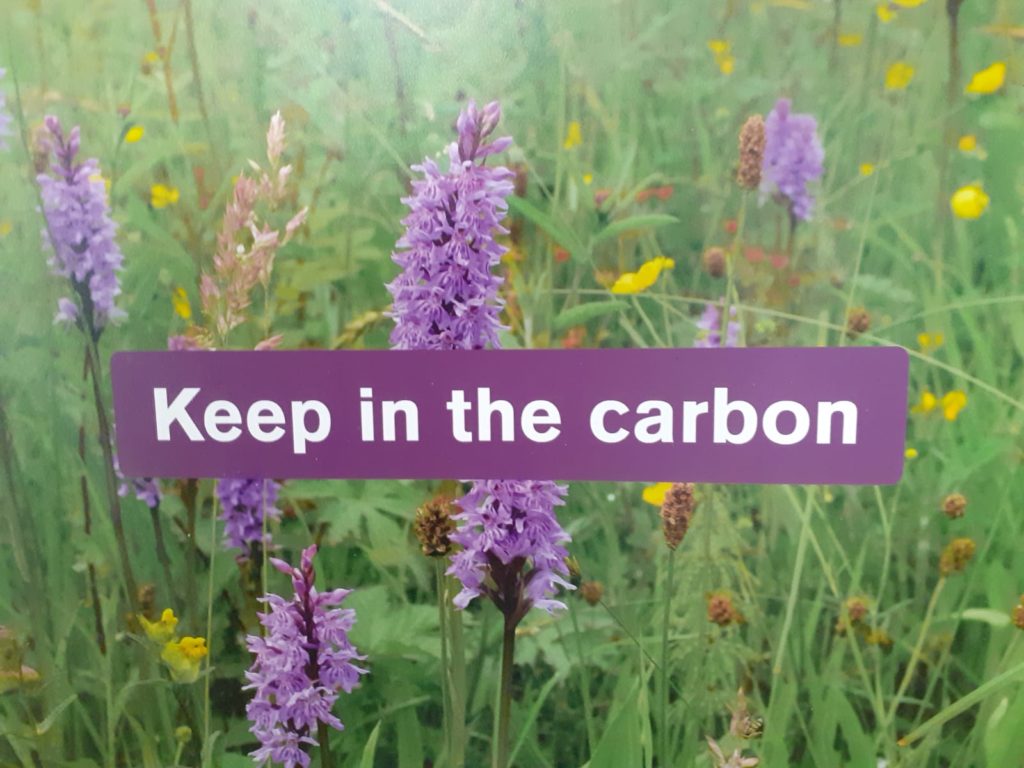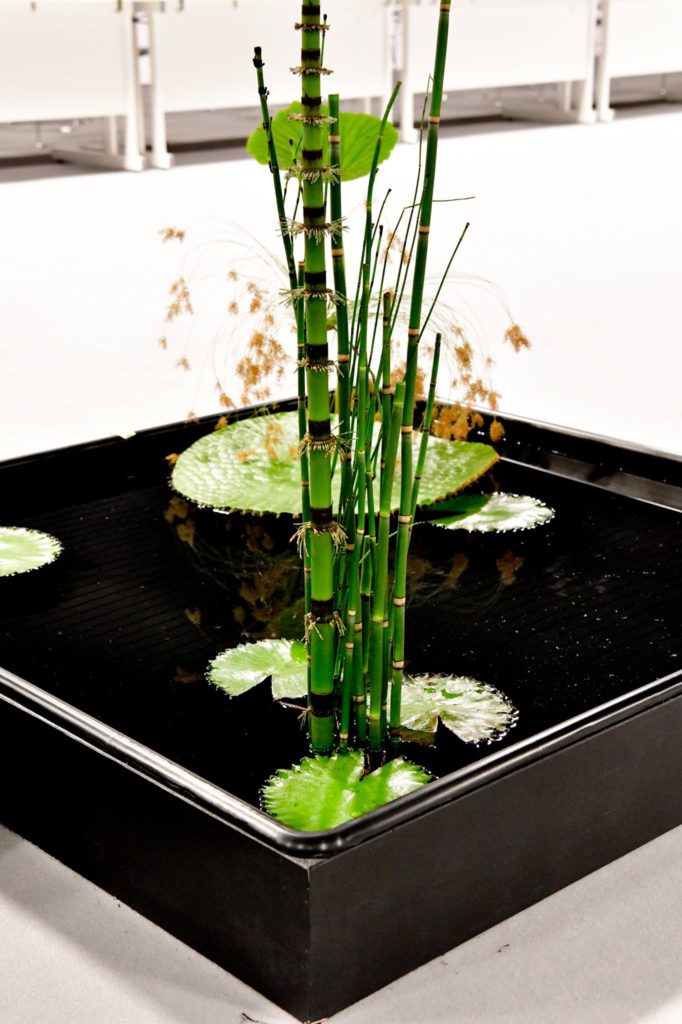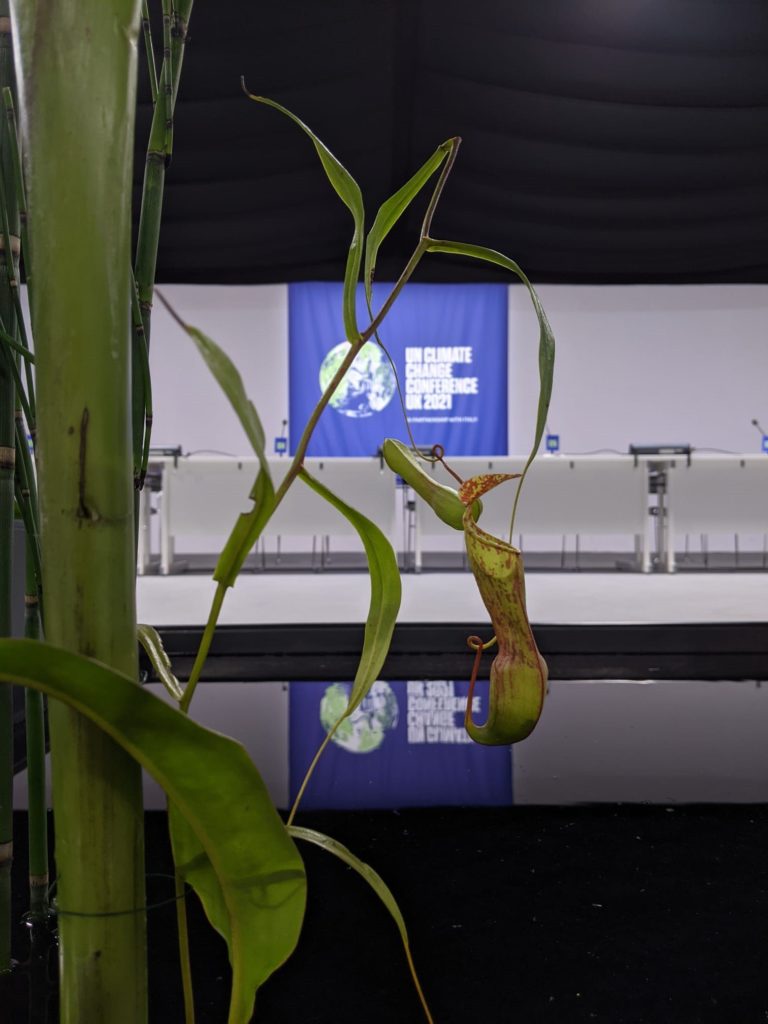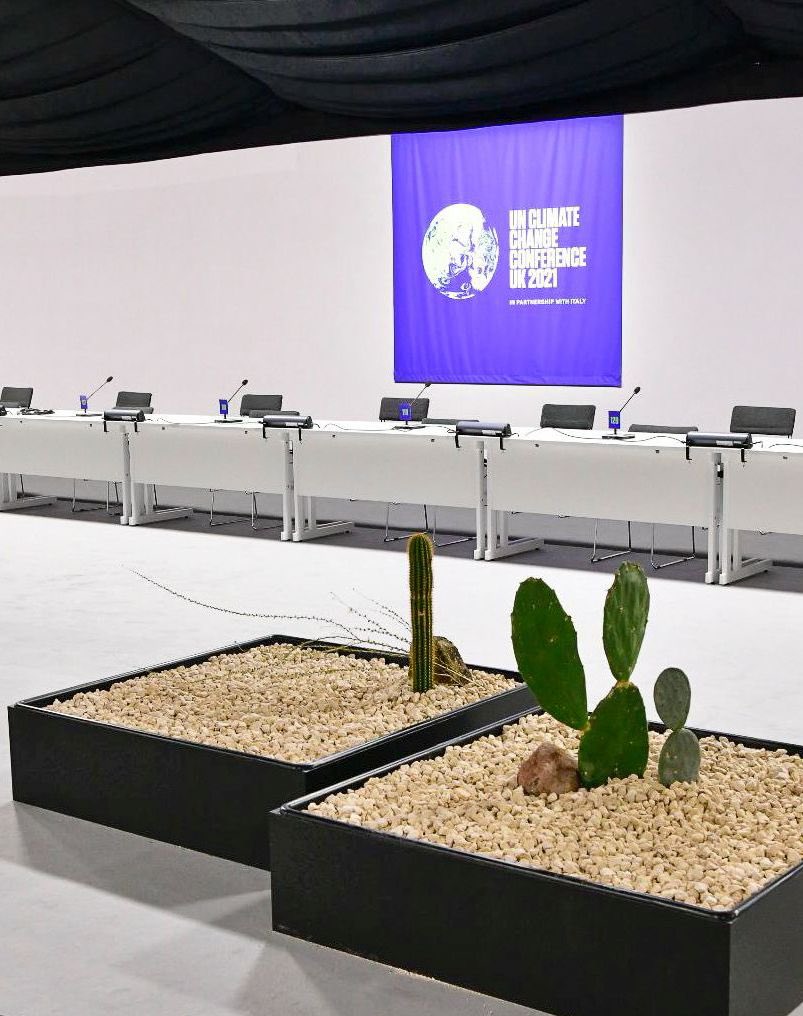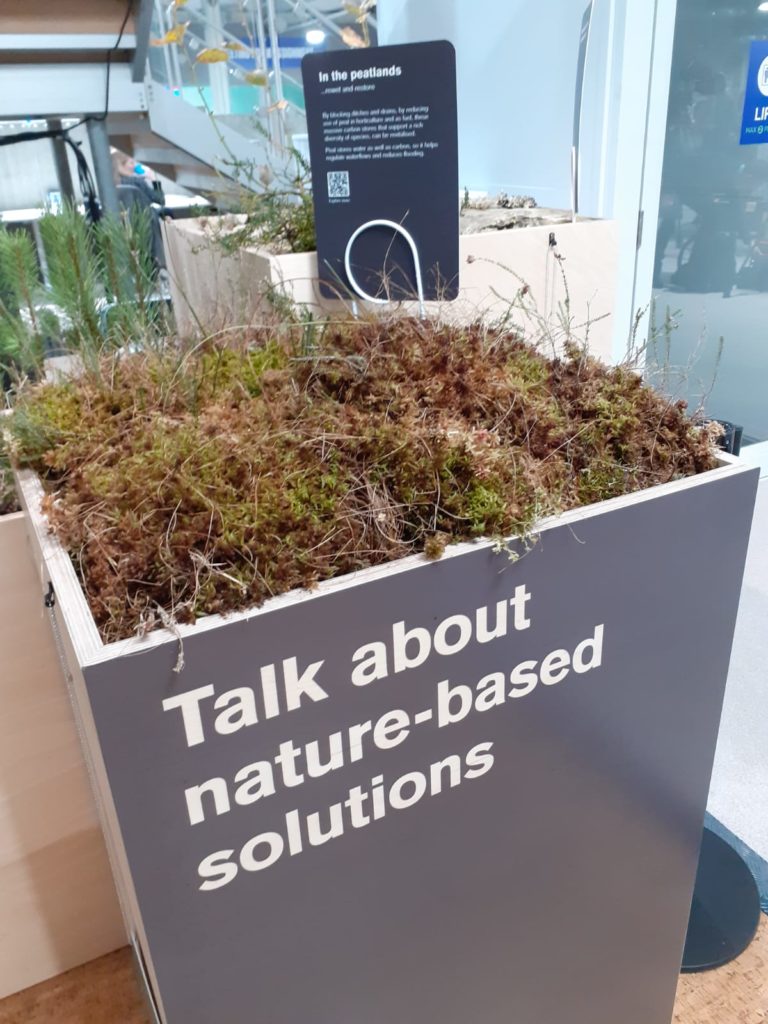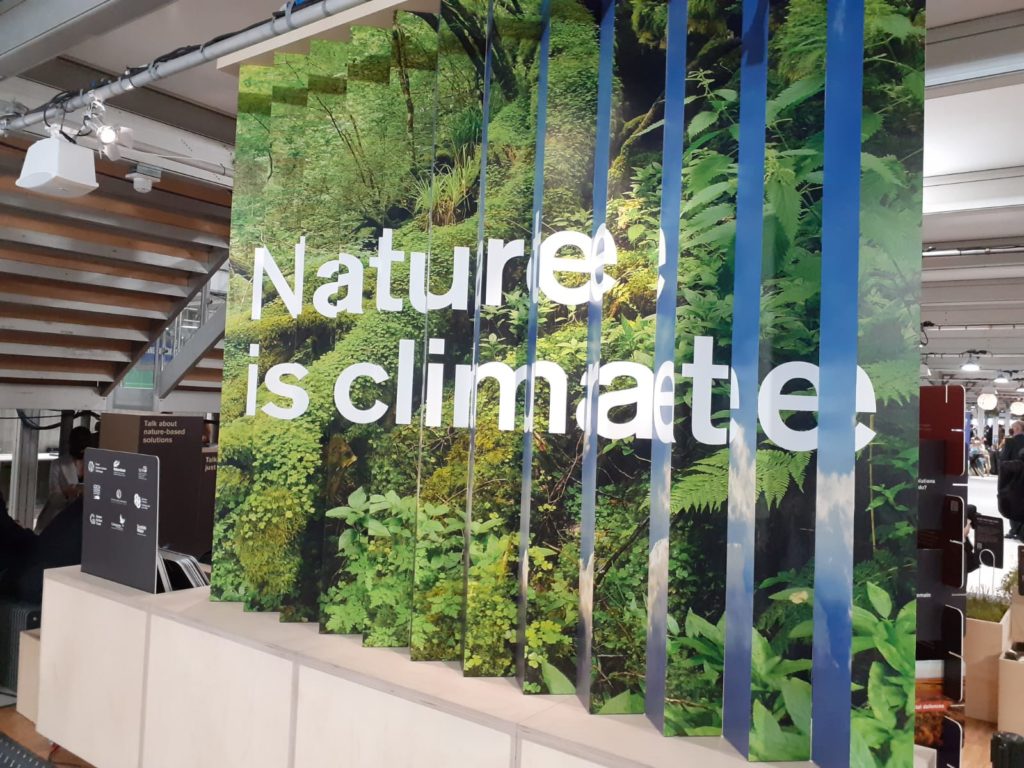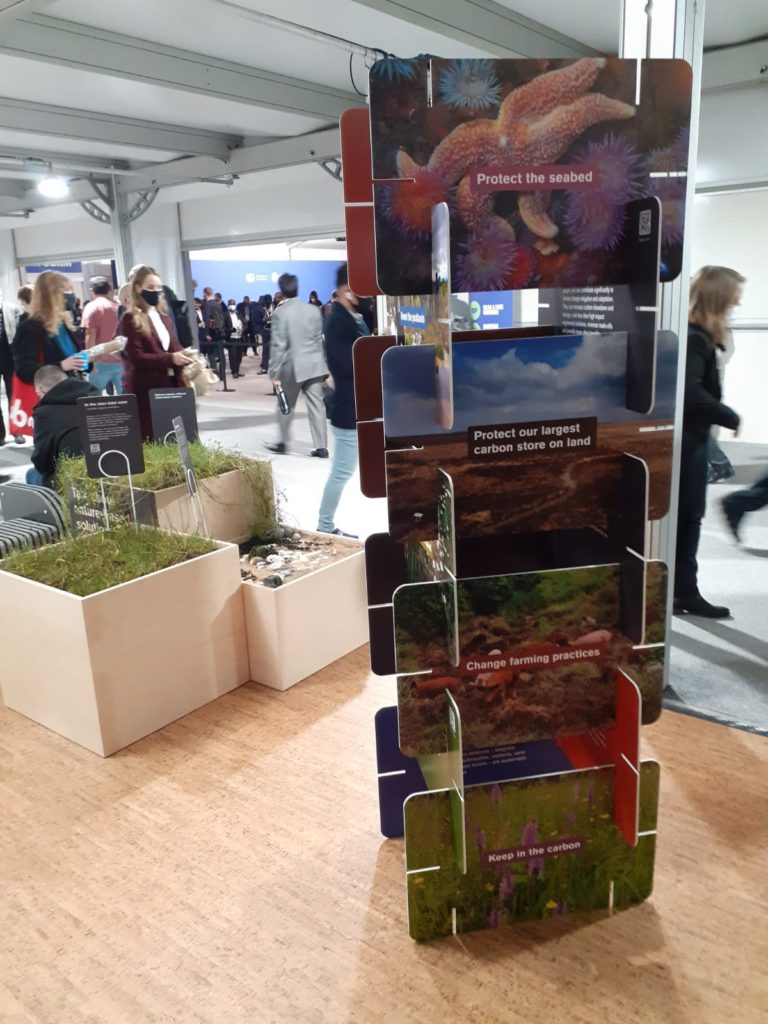It was a heady fortnight of frantic networking and tough negotiating in the Glasgow rain. But did the twenty-sixth Conference of the Parties (COP26) to the United Nations Framework Convention on Climate Change (UNFCCC) live up to its promise? Will we be able to limit global heating to 1.5C whilst protecting the most vulnerable from the effects already being felt? Or was the whole event undermined by the compromises required to keep everyone on board? And what does this mean for the Royal Botanic Garden Edinburgh (RBGE), as the delegates jet off and the exhibits are dismantled?
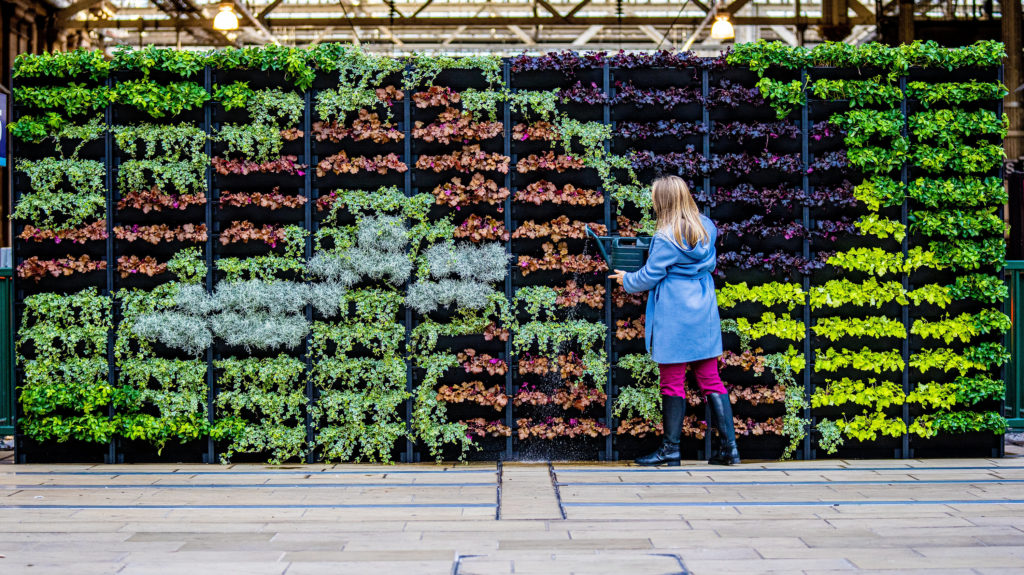
RBGE had a strong presence at the COP, explaining the science of climate change, demonstrating its impacts upon species and ecosystems, and exploring how nature can help mitigate the threat. We created thought-provoking displays of global plant life for the negotiating rooms and world leaders’ areas, contributed to stimulating installations in the ‘Blue Zone’ highlighting Scotland’s potential to provide nature-based solutions for delegates, and built a green backdrop to soothe weary travellers in transit through Edinburgh. Our creative programming helped bring Ellie Harrison’s cautionary Early Warning Signs back to Glasgow, and the Encampment of Eternal Hope provided an immersive space to amplify the underrepresented voices of young and Indigenous people.
Away from the hubbub, our Edinburgh Garden provided a welcome, quiet green space for leaders and delegates from Scotland and around the world to meet, reflect and make connections.
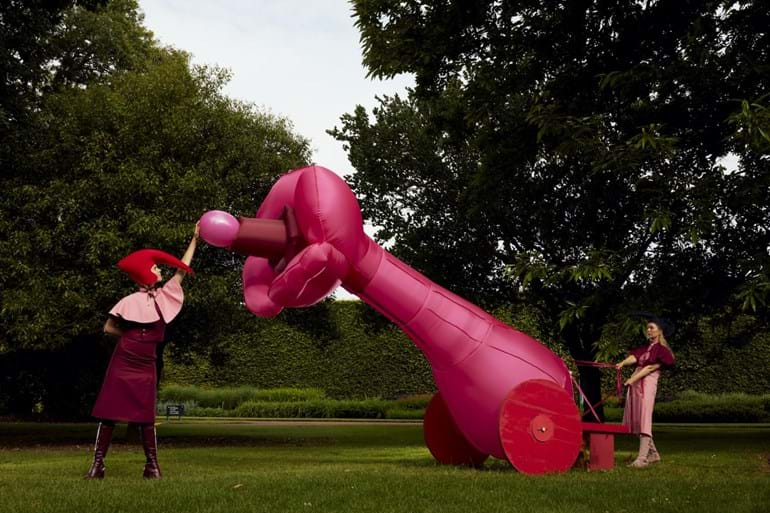
How COP26 unfolded
Saturday, 30th October As a prelude to the COP we hosted Vision Mechanics’ Storm, a ten-metre Ocean Goddess puppet created from recycled materials, en route to Glasgow, imploring us to protect the world’s oceans and coastlines.
Tuesday, 2nd November Visitors to the Climate and Nature Hub in the Blue Zone included Steven Victor, Minister for Agriculture, Fisheries and Environment of Palau, an island nation on the frontline of the climate emergency, Luis Fernando Jara and Juan Carlos Riascos of Colombia’s Programa Páramos y Bosques, and Annelice Corrales Núñez from the Costa Rican delegation.
Wednesday 3rd November The Prime Minister of Nepal, Sher Bahadur Deuba, and Nepal’s Minister for Forests and Environment, Ramsahay Prasad Yadav, with other members of the Nepalese delegation, visited our Edinburgh Garden, where the Prime Minister planted a native Nepali tree, bhojpatra (Betula utilis or Himalayan birch). RBGE’s close collaborative relationship with Nepal stretches back over 200 years.
Thursday 4th November In Glasgow we continued to make connections at the Hub, including delegates from the British Society of Soil Science, the Global Plastic Action Partnership, circular economy champions WRAP UK, Nigeria’s Green Mobilisation Initiative and the World Economic Forum. Back in Edinburgh, we welcomed the President and First Lady of the Republic of Malawi, who planted a Critically Endangered mkungusa tree (Widdringtonia whytei or Mlanje cedar) and looked forward to future collaborations with RBGE.
Friday 5th November saw the launch of Catchment Based Approach’s new Seagrass Restoration Handbook – supporting a crucial ecosystem for marine life and carbon sequestration, to which RBGE scientist Aline Finger contributed several chapters.
Sunday 7th November We partnered in the launch of Botanic Gardens Conservation International’s new Global Biodiversity Standard, aiming to ensure that tree-planting has only positive impacts for climate and biodiversity. We also watched the launch of a new film, Sustainable Summits, highlighting the impacts of climate change on ecosystems and communities in the Himalayas – among which we work in Nepal, China and Bhutan – and how development pressures may be balanced.
Monday 8th November marked the beginning of a new collaboration between RBGE and the Ivory Coast, as we welcomed the Minister of Water and Forests Alain-Richard Donwahi and Sara Amani, Ambassador to the UK, to discuss hopes for a new partnership.
Tuesday 9th November saw a half-day event in the UK Presidency Pavilion highlighting our work with NatureScot and SEFARI partners to conserve genetic diversity, contributing to Aichi Target 13. That evening RBGE’s Tropical Biologist Caroline Lehmann took part in a high-profile panel discussion presented by Food Tank, WWF and Nourish Scotland, exploring the global importance of oft-overlooked grassland and savannah systems as assets and solutions in the climate agenda.
Wednesday 10th November RBGE’s Head of Genetics and Conservation Antje Ahrends gave the opening lecture – a great overview of biodiversity and the climate emergency – at Botanic Gardens Education Network’s online conference, Climate Change – Action Through Plants.
Thursday 11th November saw Dr Ahrends again in the spotlight, speaking with Casey Ryan of Edinburgh University School of Geosciences on using satellite technology to monitor forest biodiversity and carbon in the UN Climate Change Global Innovation Hub Pavilion. Their presentation can be viewed here (starting at 17 minutes in). Antje then met Professor Dos Santos Silayo, Chief Executive of the Tanzania Forest Services Agency, Ministry of Natural Resources and Tourism, to discuss future collaborations between the Agency, RBGE and the University of Edinburgh.
Now the good news …
Of course it was not until the final weekend of the COP that negotiators really got down to thrashing out the details of the Glasgow Climate Pact, unequivocally the strongest set of measures against climate change agreed by any COP yet. Many observers noted – despite the inevitable disagreements – a spirit of cooperation between nations at COP26 that had not been seen at previous COPs. In particular, in a bilateral declaration, China and the USA pledged to enhance climate cooperation leading up to 2030 with the aim of keeping the 1.5C goal alive.
Further positive outcomes included the Glasgow Leaders’ Declaration on Forests and Land Use, a global agreement by the leaders of over 130 countries – covering 90% of the world’s remaining forest – to end deforestation by 2030. However, there is a risk this may be interpreted as a licence to cut as much as possible before the end of the decade! The agreement also takes no account of forest degradation, which is notoriously hard to measure and monitor but may lead to significant carbon emissions, not to mention biodiversity loss. Conversely, already degraded (for instance, selectively-logged) forests are both valuable and recoverable, even with minimal intervention, and should not be written off as expendable.
In tandem with this, Dr Ahrends reported significant progress in developing tools for monitoring and reporting on the state of forests, through a UN Food and Agriculture Organisation programme dubbed REDD+ (Reducing Emissions from Deforestation and Forest Degradation). Increasingly high resolution satellite monitoring – such as that provided by Norway’s International Climate and Forests Initiative Imagery Program – is, she says “an absolute game changer” to support forest conservation.
The Global Methane Pledge to reduce methane emissions by 30% below 2020 levels by 2030, which could, alone, avert 0.2C of global heating, has now been signed by more than 100 countries (notably excluding China, India and Russia).
It wasn’t just about political leaders. The Glasgow Financial Alliance for Net Zero, a consortium of more than 450 major financial institutions led by former governor of the Bank of England, Mark Carney, announced a commitment to align their $130 trillion investment portfolio with Net Zero emissions by 2050. With global heating already heading over 1C, however, 2050 may be too late. And a group of global charities joined forces with the UK, US, German, Dutch and Norwegian governments in a $1.7 billion pledge to support Indigenous peoples and local communities, a move cautiously welcomed as a first step towards recognising Indigenous rights as central to a just resolution of the climate crisis.
The Glasgow Pact recognizes – as RBGE and partners had highlighted – the interlinked nature of the climate and biodiversity crises, with nature acknowledged, more strongly than at previous COPs, as an integral part of climate mitigation and adaptation “by acting as sinks and reservoirs of greenhouse gases and protecting biodiversity, while ensuring social and environmental safeguards”. For instance, in Scotland, damaged peatlands are the second largest source of carbon emissions and a key focus of restoration efforts to improve our carbon balance – by which they can recover remarkably rapidly.
In addition to mitigation, nature can contribute significantly to adaptation. Sea grass meadows, covering a mere 0.1% of the world’s oceans, not only account for 10% of marine carbon sequestration, but also protect shorelines against flooding and wave damage through the accumulation of silt. As RBGE’s Head of Cryptogams, Chris Ellis, noted, there are strong and significant similarities to habitat conservation across the world: “Sea grass in the Atlantic, mangroves around the Pacific islands; peatlands in Scotland and the carbon-rich soils of the páramo in Colombia – the solutions show remarkable parallels”. This makes bilateral treaties, such as a new agreement forged between Scotland and Chile to share knowledge and expertise on the conservation and management of wetlands, very valuable.
On the whole, most nations of the world now appear to be taking the UN’s ‘Code Red for humanity’ seriously. Despite a large fossil fuel lobby, COP26 was the first to make explicit mention of this industry as one of the root causes of climate change, sending a clear message to investors that coal, oil and gas will rapidly become a ‘stranded assets’. But differences do remain over the rate at which nations believe we should wean ourselves off these fuels, with a minority slowing the pace.
… and the bad
The most controversial last-minute change was the watering-down of wording to “phase-out” the unabated use of coal – the most climate-damaging fuel, currently responsible for around 40% of carbon dioxide emissions – to a mere “phasedown” at the insistence of negotiators from major coal-using countries including India, China and South Africa. The Pact still calls for the phase-out of inefficient fossil fuel subsidies – although how “inefficient” will be defined is anyone’s guess. While 40 countries have pledged to quit coal altogether, major emitters, such as Australia, China, India and the US, did not.
An initiative to phase out the other fossil fuels – the Beyond Oil and Gas Alliance – was launched, led by Costa Rica and Denmark. However the alliance has only eight core members (the others are France, Greenland, Ireland, the Canadian province of Quebec, Sweden, and Wales) and three associates: Portugal, New Zealand and the US state of California. The other nations of the UK are not signed up – and projects such as the Cambo oil field are still projected to go ahead.
The text of the Pact recognises a need for the Global North to increase financial support to those countries already suffering the effects of climate change, beyond the current $100bn target. However, many low income countries and small island states remain disappointed by the slow trickle of finance made available to mitigate and adapt to climate change, and by the lack of compensation committed for the loss and damage they will face, and are already facing, due to climate-induced extreme weather events. Their requests are considered by some to have been “sacrificed on the altar” of getting a deal agreed in Glasgow at all costs. The COP26 Coalition – representing some of the world’s biggest environmental organisations, civil society groups and racial justice networks – slammed the Pact as an “utter betrayal of the people”, stating that it is “immoral for the rich to sit there talking about their future children and grandchildren, when the children of the south are suffering now”.
According to the Intergovernmental Panel on Climate Change (IPCC), by 2030, carbon emissions must fall by 45% compared to 2010 levels to sustain a good chance of limiting global heating to 1.5C (and thereby saving some of the Arctic ice pack, a small proportion of the world’s coral reefs, and limiting sea level rises to around half a metre, among other predicted impacts). The pledges in the Glasgow Pact will not achieve this, but they do just keep open the possibility of achieving such changes at COP27.
Given that we have already seen warming of approximately 1.2C, many now consider it likely that the planet will go above 1.5C at least for some years, before long-term solutions (such as reforestation) begin to have an effect. According to the independent Climate Action Tracker, full implementation of all nations’ near-term current target emissions (‘nationally determined contributions’, or NDCs) would lead to a predicted global temperature rise of 2.4C by 2100. Full implementation of all pledges made up to and including Glasgow would give an estimated rise of 2.1C, and full implementation of all NDCs, net zero targets and long-term strategies might lead to warming of 1.8C (with an error range of 1.5-2.4C).
Thus, there remains a significant gap between the Glasgow Pact which “reaffirms the long-term global goal to … pursue efforts to limit the temperature increase to 1.5C above pre-industrial levels” and the parties’ current stated climate actions. As the BBC’s Roger Harrabin put it, “The bad news is that if every government does everything it promises, the world will still face a catastrophic temperature rise of around 2C.” All eyes will, therefore, be on Sharm El Sheikh in November 2022, by which time all UN countries have agreed reconsider their climate action plans, incorporating more ambitious emissions reduction targets for 2030. Given that many countries already claim to have reached their limit, however, some remarkable turnarounds are needed within that time if the hope of 1.5C is to be resurrected.
Where do we go from here?
The obvious answer to that is “Egypt” – but there is much to be done over the next crucial year before the circus starts up again at COP27. During this time, Botanic Gardens have a crucial role to play, not least with the increasingly acknowledged bi-directional linkage between climate and biodiversity, as we look first to the COP15 of the Convention on Biological Diversity (CBD) in Kunming, China, in April 2022.
As Scotland’s National Botanical Institute with an unrivalled programme of education and public engagement, a seat at the table in the EELG, and key relationships with governments, institutions, NGOs and public and private landowners, RBGE’s most obvious roles lie in stimulating individual behaviour change, and developing and promoting nature and community-based solutions with support from partner institutions at home and overseas.
As Dr Ellis observed, at COP26 it was delegates from the Global South who seemed to engage most with the nature-climate connection, and whose nations had already effected changes such as long-term and sustainable payments to farmers for achieving carbon storage through sensitive habitat management. We now need to promote these types of solutions more strongly in the Global North.
At the same time we must be aware that, with temperatures already nudging 1.2C above baseline, the window for achieving Net Zero is extremely short. Many nature-based solutions to climate change are long-term options (as is investment in developing technologies such as large-scale carbon capture): neither can substitute for the effective, immediate reductions in emissions required to prevent catastrophic global heating. These essential, urgent reductions can only be achieved by halting the extraction and burning of fossil fuels, the destruction of forests, unsustainable cultivation of livestock, and so on, which in turn require changes in government policies, subsidies, and rapid transformation of businesses and markets. Dr Ahrends agrees: “reduced forest conversion now is urgent and necessary” – and there is a critical gap before the Glasgow Leaders’ Declaration on Forests and Land Use comes into effect.
As the EELG Hub highlighted, “Nature is climate – climate is nature”. That is, the interaction works both ways: in addition to the role nature can play in mitigating the climate emergency, we need to shout about the impact the climate emergency is having – already – on nature. The work carried out by botanic gardens and other scientific institutions, to show how global heating is causing real changes to the Earth’s biota, can be a powerful tool to stimulate awareness and action. Our 150-year phenology programme and three million herbarium specimens are rich sources of data showing how not only flowering and fruiting times, but also plant distributions, are already responding in ways that may have devastating consequences. In fact, phenology monitoring is described by the IPCC as “perhaps the simplest process in which to track changes in the ecology of species in response to climate change”. In response, we now help coordinate the African Phenology Network to document changes in the fruiting patterns of forest trees across sub-Saharan Africa, with impacts already being seen among large mammal populations.
The UK’s Chief Scientific Adviser Sir Patrick Vallance was right to state that the climate emergency is a far bigger and deadlier problem than Covid19. But was he also right to pin his hopes on future innovation and technology? Our research, evidencing how climate change is having real, disastrous impacts on biodiversity right now, gives us a platform to argue for immediate changes in policy and behaviour.
As a trusted source of scientific information, RBGE has significant influence with both public and policymakers at home and overseas. We must share our empirical evidence widely to encourage the transfer of funding away from fossil fuel production, towards protecting and restoring our remaining forests, peatlands, and grasslands following scientifically-sound principles, and supporting those most affected by the effects of climate change and least able to protect themselves.
As we move forward with our ambitious new restoration and interpretation programme, Edinburgh Biomes, our Education and Engagement teams also have the opportunity to reach new audiences with the message that climate change is happening, and that we can all slow its progress by making behaviour and lifestyle changes.
With a long history of effective ‘plant diplomacy’, we can support the Scottish Government as it seeks to advocate for ambitious global policy changes to protect the natural world and human lives and livelihoods. We can bring together leaders in the inspirational environment of our Gardens, and we can play a critical role working with partner institutions in key nations. For instance, looking to China, hosts of the upcoming biodiversity COP15, we have strong, trusted relationships with many key players in Kunming, Beijing, and elsewhere.
With collaborative projects in place across many parts of the Global South, RBGE is also in a position – and as a beneficiary of past colonial activities, has a clear responsibility – to help co-create resilience and adaptation among impacted communities. Working with our long-term partners, we have the capacity to amplify the voices of those in the Global South for whom Glasgow did not deliver what, as First Minister Nicola Sturgeon says, they “rightly demanded”. By continuing to foster these relationships as scientific equals, collaborators, co-creative practitioners and mutual learners, we can act as a critical conduit of information and opinion between Global North and Global South in both directions.
There is no doubt that the time for sugar-coating the climate change message is over. Life on earth as we know it is in peril and, while COP26 may have kept the dream of 1.5C alive, it remains very much on life support. With six months until CBD COP15, and only a year until the next UNFCCC COP27, there is no time to waste.
